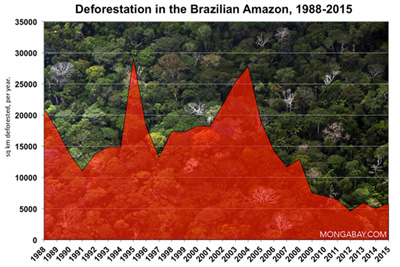Deforestation in the Brazilian Amazon has fallen since last year, say Brazilian officials.
Data from INPE, Brazil’s Space Agency, show a 49 percent decline in the August 2009-June 2010 window, relative to the year earlier period. INPE says forest clearing fell from 1,875 square kilometers to around 1125 sq km, but cautioned that the figures are still far from finalized. Annual deforestation data for Brazil is typically tabulated at the end of July when cloud cover is at a low in the region and analysts have conducted higher resolution assessment of forest extent.
 |
Imazon, a Brazil-based NGO that tracks deforestation, says that only about half the Brazilian Amazon was visible by satellite during April and May due to cloudy conditions. Imazon’s analysis, released last month, showed a seven increase in deforestation between August 2008-May 2009 and August 2009-May 2010, from 1084 sq km to 1161 sq km. Final figures are expected in late August or September.
Deforestation in the Brazilian has fallen substantially since 2004 when clearing reached 27,000 sq km. In 2008, President Lula announced a plan to reduce deforestation by 70 percent from a 1996-2005 baseline under his climate change action plan. So far Brazil is ahead of its target.
Related articles
Rainforest conservation: a year in review
(12/27/2009) 2009 may prove to be an important turning point for tropical forests. Lead by Brazil, which had the lowest extent of deforestation since at least the 1980s, global forest loss likely declined to its lowest level in more than a decade. Critical to the fall in deforestation was the global financial crisis, which dried up credit for forest-destroying activities and contributed to a crash in commodity prices, an underlying driver of deforestation.
Brazil could halt Amazon deforestation within a decade

(12/03/2009) Funds generated under a U.S. cap-and-trade or a broader U.N.-supported scheme to reduce greenhouse gas emissions from deforestation and degradation (“REDD”) could play a critical role in bringing deforestation in the Brazilian Amazon to a halt, reports a team writing in the journal Science. But the window of opportunity is short — Brazil has a two to three year window to take actions that would end Amazon deforestation within a decade.
Concerns over deforestation may drive new approach to cattle ranching in the Amazon

(09/08/2009) While you’re browsing the mall for running shoes, the Amazon rainforest is probably the farthest thing from your mind. Perhaps it shouldn’t be. The globalization of commodity supply chains has created links between consumer products and distant ecosystems like the Amazon. Shoes sold in downtown Manhattan may have been assembled in Vietnam using leather supplied from a Brazilian processor that subcontracted to a rancher in the Amazon. But while demand for these products is currently driving environmental degradation, this connection may also hold the key to slowing the destruction of Earth’s largest rainforest.
Brazil’s plan to save the Amazon rainforest

(06/02/2009) Accounting for roughly half of tropical deforestation between 2000 and 2005, Brazil is the most important supply-side player when it comes to developing a climate framework that includes reducing emissions from deforestation and forest degradation (REDD). But Brazil’s position on REDD contrasts with proposals put forth by other tropical forest countries, including the Coalition for Rainforest Nations, a negotiating block of 15 countries. Instead of advocating a market-based approach to REDD, where credits generated from forest conservation would be traded between countries, Brazil is calling for a giant fund financed with donations from industrialized nations. Contributors would not be eligible for carbon credits that could be used to meet emission reduction obligations under a binding climate treaty.














